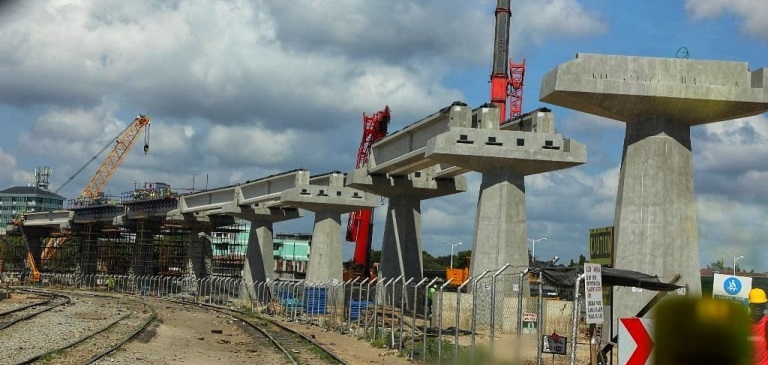The Socio-Economic Upliftment from the SGR Lot 5
While the nation is eagerly waiting for the completion of the Dar es Salaam – Mwanza Standard Gauge Railway (SGR) to manifest its economic significance, for the people living along the SGR Lot 5 Project line, the wait is the yesterday news, for they are already reaping the multiplying effects of the project.
One of the indispensable milestones of the ongoing construction of the SGR Lot 5 project is the Seke Sleepers Plant, located at Seke village situated between Malampaka and Shinyanga stations, famous for being the death and burial place of the Sukuma tribe phenomenal and miracle man, Ng’wanamalundi.
The project pours numerous economic benefits back into the hosting community through employment, vocational skills, local suppliers, and stimulation of several businesses and trade, which adds value to the agriculture value chain for farmers and SMEs along the line.
The local content nature of the SGR Lot 5 project requires labor ratio standards of 80 percent locals to 20 percent foreigners, and it has been complied with. The Seke Sleepers Plant employs 231 of about 7,000 employees hired for lot five construction.
“The good thing about this factory is that all these workers you are seeing here are Tanzanians, and majority were drawn from local communities,” says Lot 5 Project Manager, engineer Christopher Callist, adding that on completion of the project the employees, majority of which are youth will be will be equipped with new skills, experience and most important the confidence of being part of the team that delivered such a huge project.
“To me, the level of confidence to these young and energetic people is fundamental; once you have skills, experience coupled with confidence, I am optimistic that after here, these guys can move mountains and they won’t be the same young men and women we found at the start of the project.”
Upon hiring, all employees were put on spegivenraining by contractors; China Civil Engineering Construction Corporation (CCECC) and China Railway Construction Company (CRCC), to enable them to keep pace with the SGR construed SGR construction.
“I have technical skills from Veta, but after going through the induction course, I was exposed to the real new technology, with the experience we have here even after the project is over, if this factory remains here we can still operate it efficiently,” says Solomon Mgine, who works at the plant.
The Seke Sleepers plant covers the total construction of around 1680 square meters, which produces about 531,100 concrete sleepers in section 5 of the SGR center line. The sleepers’ storage area is approximately 15,000 square meters, and the designated maximum storage capacity is 100,000 pieces of sleepers.
According to the lot 5 project manager, the sleepers’ production of the project adopts the stretching bed for long line production, which is a total of four line production lines, and each production line is equipped with 50 groups of one-by-eight sleeper steel mold with a daily production capacity of 1600 pieces.
“All four production lines in the sleeper plant are capable of producing ordinary sleepers, among which, one production line will be transformed into bridge sleeper production line in due course to produce guard rail sleepers,” said engineer Callist.
According to the project manager, there are 7,000 direct employees; almost 80 percent are drawn from local communities along the railway line. “We hired people of different levels of education and professions, all were trained here, and now the majority of the work is done by people from around the hosting villages,” says Callist.
The Dream of a Unified East Africa
The proposed electrified SGR line from Mwanza to Isaka has 249 kilometers of mainline and 92 kilometers of passing loops, undertaken under the design and build contract. The RAMS (Reliability, Availability, maintainability, and Safety) passes through three regions of Mwanza, Simiyu, and Shinyanga, which entails the construction of culverts, underpasses, overpasses, bridges, and service ducts.
Overpasses and underpasses are provided where the proposed SGR intersects with existing roads or where humans and livestock will need to cross to the other side of the SGR, and service ducts are provided in collaboration with other utility providers stakeholders to allow their services to cross the railway without disturbing the line.
The Tanzania SGR project objectives aim at promoting reliable mobility along the Central Corridor of Tanzania through the construction of the railway line from Dar es Salaam to Mwanza and new lines from Isaka to Kigali in Rwanda and Uvinza to Musongati in Burundi. There are also plans for connecting Burundi and DRC Congo with the SGR, which will then connect DRC to the Port of Dar es Salaam. Such upgrades and construction shall lead to the unlocking of the central corridor of the East African Community (EAC), which has the potential for agriculture and mining.
The SGR Project is in line with the overall aim of the government to revitalize and reinvigorate the rail sector so as it can contribute more to the national economy. Moreover, currently over 95 percent of the traffic leaving the port of Dar es Salaam is transported by road to the detriment of the road network. It is thus expected that the upgrading of the rail sector, especially the Dar es Salaam- Isaka-Mwanza link, will increase freight and passenger capacity as well as release pressure on the road network.
The SGR is also expected to reduce the travel times for goods and passengers and bring enormous benefits to the people of Tanzania and its neighbors. Freight costs are estimated to be reduced by 40 percent. Every train takes 500 lorries from the road, significantly cutting pollution, congestion, and risk to people and vehicles using the highway.

